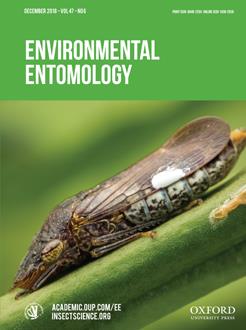In the Central American region, the aggressive, sibling bark beetles Dendroctonus frontalis Zimmermann (Coleoptera: Curculionidae: Scolytinae) and Dendroctonus mesoamericanus Armendáriz-Toledano & Sullivan (Coleoptera: Curculionidae: Scolytinae) commonly colonize pines concurrently, and in nature they avoid heterospecific pairing, although it can be produced in the lab. We performed walking arrestment bioassays in the lab to examine the capacity of both sexes of both species to discriminate odors from frass expelled from gallery entrances of either solitary females or conspecific pairs of either species. Males of both species strongly preferred odors of frass from solitary, conspecific females over those of heterospecific females or pairs of either species. Female D. frontalis did not discriminate among these frass categories, whereas female D. mesoamericanus preferred frass of conspecific females. In gas chromatography–electroantennographic detection and gas chromatography–mass spectrometry analyses, we determined that males of both species could sense a nearly identical spectrum of approximately 16 host- and beetle-produced compounds present in frass of females of one or both species. Only two of these compounds, endo-brevicomin and ipsdienol, which were present in frass of female D. mesoamericanus and pairs of either species but absent in frass of solitary D. frontalis females, qualitatively distinguished these categories. Several known attractants and synergists for either species declined in concentration postpairing. Our results complement earlier research and indicate how semiochemical composition and concentration in frass might mediate male discrimination of attack sites of conspecific, unpaired females. Furthermore, our data indicate that semiochemical responses for walking females differ from those of males and between species.
How to translate text using browser tools
9 October 2018
Discrimination of Odors Associated With Conspecific and Heterospecific Frass by Sibling Species Dendroctonus frontalis (Coleoptera: Curculionidae: Scolytinae) and Dendroctonus mesoamericanus (Coleoptera: Curculionidae: Scolytinae)
Alicia Niño-Domínguez,
Brian T. Sullivan,
Jose H. Lopez-Urbina,
Jorge E. Macías-Sámano
ACCESS THE FULL ARTICLE
It is not available for individual sale.
This article is only available to subscribers.
It is not available for individual sale.
It is not available for individual sale.

Environmental Entomology
Vol. 47 • No. 6
December 2018
Vol. 47 • No. 6
December 2018
electroantennogram
olfactometer
pheromone
reproductive isolation
syntopy




